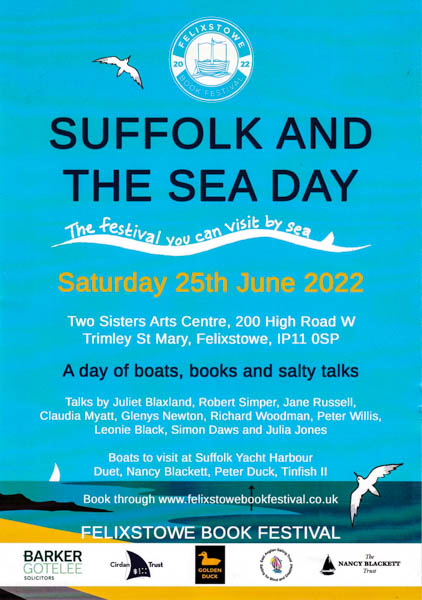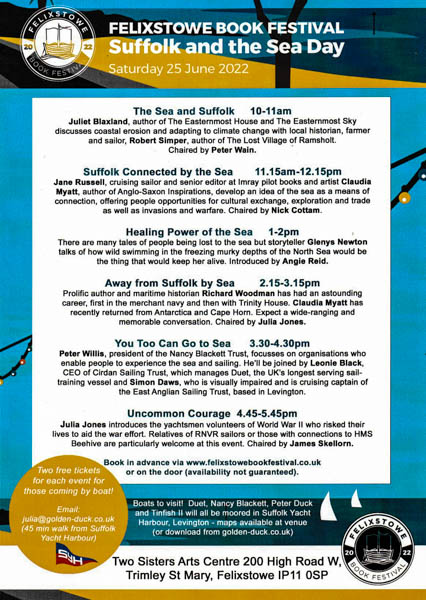by Claudia Myatt
Every spring and early summer there is a conversation between River Deben sailors that goes something like this:
‘Have you been over the bar yet?’
‘No, but I’ve got the chartlet, hoping to go round to the Orwell next weekend’
‘What’s it like this year?’
‘Shifted a bit in that storm I hear – quite narrow now. Wouldn’t risk it until after half tide with my draft’
‘Deepest water is usually close to the beach but the tide runs hard there….’
I wonder if the Anglo-Saxons who used the Deben river as their regular highway had similar conversations centuries ago. Did Raedwald’s captain ever worry about what his punishment might be for putting the king’s ship aground on the shingle? Maybe not, as it’s likely that the river entrance was deeper and wider then than it is now, and the river a busy trading route. But one thing that doesn’t change is the importance of a safe landfall.
We treat the coast now as the place where our country ends. The coastline is a border and the sea is the damp no-man’s land between us and somewhere else. But what if we change that thinking to the way the Anglo-Saxons would have seen it – that the sea connects rather than divides us, and all the fringes of the North Sea become one land? Regular sea travel between Scandinavian, Germanic and East Anglian coasts was not ‘invading a foreign land’ but possibly more like popping over to visit your neighbours and do some shopping. A few centuries later, the Vikings had more destructive intentions towards these shores but the Anglo-Saxon tribes, whilst of course loving a bit of a fight, were excellent tradesmen. The materials used to make the Sutton Hoo treasure came through trade routes bringing garnets from India, glass from the Mediterranean and gold from goodness knows where.
You can tell I’m not a proper historian when describing a warrior tribe as ‘liking a bit of a fight’ but you don’t have to be a history expert to wonder about what life was life around these shores 13 centuries ago. A bit of imagination and a spirit of curiosity makes history interesting for us all.
Projects like the replica Sutton Hoo ship in the Longshed and the excavations at Rendlesham are helping to bring it all to life. I recommend the website Suffolk Heritage Explorer which has some excellent updates on the finds at Rendlesham (heritage.suffolk.gov.uk/rendlesham) including the ‘Rendlesham Revealed’ community archaeology project.
Living on the river in Woodbridge with a good view of Tranmer House from my wheelhouse window, it’s no surprise that the Sutton Hoo treasure designs have found their way into my sketchbooks. People love patterns – we always have and probably always will – and it’s fascinating to see just how universal they can be. Patterns cross borders as widely as people do. Knotwork designs, for example, are found all over the world, but each culture and era in history has its own signature style Trying to draw some of the Sutton Hoo treasure designs, even the simplest ones, is a humbling experience. Pencil and paper (and photoshop!) are simple materials compared to garnets, glass and gold but it’s still a challenge. Here’s the easiest one to begin with, the universal ‘triquetra’ or three-fold knot:
My latest book ‘Anglo-Saxon Inspirations’ started as a colouring book but then it seemed a good idea to include some step by step instructions on how to draw some of the simpler brooch and panel designs – it’s a good way of feeling that sense of continuity with our history.
As every sailor knows (especially sailors without engines), rivers and estuaries make the difference between an approachable and a dangerous coast. Historians think it’s no coincidence that so many significant Anglo-Saxon sites have been found around the Suffolk rivers. The way that our coastline connects not just to history but to the present and the wider world will be celebrated on Saturday 25th June in a fringe event of Felixstowe Book Festival. ‘Suffolk and the Sea’ takes place at the Two Sisters Arts Centre in Trimley, walking distance from Suffolk Yacht Harbour, so a day of fascinating talks and interviews organised by RDA’s Julia Jones can be enhanced by visits to some of the boats featured in the programme.
I’ll be there discussing all things Anglo-Saxon and seafaring with Jane Russell, who is well qualified to know how important a safe landfall is to a sailor. Jane is an editor and author of pilot books as well as an experienced sailor. She and her husband completed a five-year circumnavigation as well as a 15 month voyage to the Mediterranean and back with their children. Jane works as Editor at Imray Publishing and is also the Royal Cruising Club Pilotage Foundation’s Editor in Chief. Jane’s Tinfish II will be one of the yachts available to visit during the day, along with Arthur Ransome’s Nancy Blackett Julia Jones’ Peter Duck and the Cirdan Trust’s Duet. If you like boats to have literary or historical connections, or you like your literature and talks to have a salty tang, Suffolk and the Sea will be the perfect event! Book online through www.felixstowebookfestival.co.uk/bookings
On a changing coastline like the East Coast, pilot books need regular updates. I’d love to see what an Anglo-Saxon version would have looked like!
I’ve also been given the opportunity to share a conversation with author and Trinity House pilot Richard Woodman which will take us as far from the Suffolk coast in miles as the Anglo-Saxons were in years. All in all, a good opportunity to deepen our appreciation of our unique coastline and rivers.
Claudia Myatt
Claudia is an illustrator, art tutor, writer and musician with a passion for all things maritime. She lives on an elderly tug boat on the Deben and is often seen pottering on the river in her dinghy or sketching from her kayak.














